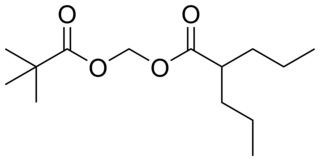
Nandrolone, also known as 19-nortestosterone, is an endogenous androgen which exists in the male body at a ratio of 1:50 compared to testosterone. It is also an anabolic steroid (AAS) which is medically used in the form of esters such as nandrolone decanoate and nandrolone phenylpropionate. Nandrolone esters are used in the treatment of anemias, cachexia, osteoporosis, breast cancer, and for other indications. They are now used by oral administration or instead are given by injection into muscle or fat.

Testosterone cypionate, sold under the brand name Depo-Testosterone among others, is an androgen and anabolic steroid (AAS) medication which is used mainly in the treatment of low testosterone levels in men. It is also used in hormone therapy for transgender men. It is given by injection into muscle or subcutaneously, once every one to four weeks, depending on clinical indication.

Oxabolone cipionate, or oxabolone cypionate, also known as 4-hydroxy-19-nortestosterone 17β-cypionate or estr-4-en-4,17β-diol-3-one 17β-cypionate, is synthetic and injected anabolic–androgenic steroid (AAS) and derivative of nandrolone (19-nortestosterone) which has been marketed in Europe. It is the C17β cypionate ester and a prodrug of oxabolone (4-hydroxy-19-nortestosterone).

O-Acetylpsilocin is a semi-synthetic psychoactive drug that has been suggested by David Nichols to be a potentially useful alternative to psilocybin for pharmacological studies, as they are both believed to be prodrugs of psilocin. However, some users report that O-acetylpsilocin's subjective effects differ from those of psilocybin and psilocin. Additionally, some users prefer 4-AcO-DMT to natural psilocybin mushrooms due to feeling fewer adverse side effects such as nausea and heavy body load, which are more frequently reported in experiences involving natural mushrooms. It is the acetylated form of the psilocybin mushroom alkaloid psilocin and is a lower homolog of 4-AcO-MET, 4-AcO-DET, 4-AcO-MiPT and 4-AcO-DiPT.

Pivampicillin is a pivaloyloxymethyl ester of ampicillin. It is a prodrug, which is thought to enhance the oral bioavailability of ampicillin because of its greater lipophilicity compared to that of ampicillin.
Combined injectable contraceptives (CICs) are a form of hormonal birth control for women. They consist of monthly injections of combined formulations containing an estrogen and a progestin to prevent pregnancy.

Talampicillin is a beta lactam antibiotic from the penicillin family. It is an acid stable prodrug that was administered orally. It is not approved by the FDA for use in the United States. It should be avoided in Liver diseases

Estradiol cypionate (EC), sold under the brand name Depo-Estradiol among others, is an estrogen medication which is used in hormone therapy for menopausal symptoms and low estrogen levels in women, in hormone therapy for trans women, and in hormonal birth control for women. It is given by injection into muscle once every 1 to 4 weeks.

Valproate pivoxil is an anticonvulsant used in the treatment of epilepsy. It is the pivaloyloxymethyl ester derivative of valproic acid. It is likely a prodrug of valproic acid, as pivoxil esters are commonly employed to make prodrugs in medicinal chemistry.
An estrogen ester is an ester of an estrogen, most typically of estradiol but also of other estrogens such as estrone, estriol, and even nonsteroidal estrogens like diethylstilbestrol. Esterification renders estradiol into a prodrug of estradiol with increased resistance to first-pass metabolism, slightly improving its oral bioavailability. In addition, estrogen esters have increased lipophilicity, which results in a longer duration when given by intramuscular or subcutaneous injection due to the formation of a long-lasting local depot in muscle and fat. Conversely, this is not the case with intravenous injection or oral administration. Estrogen esters are rapidly hydrolyzed into their parent estrogen by esterases once they have been released from the depot. Because estradiol esters are prodrugs of estradiol, they are considered to be natural and bioidentical forms of estrogen.

Estradiol dienanthate (EDE), sold under the brand names Climacteron among others, is a long-acting estrogen medication which was previously used in menopausal hormone therapy for women and to suppress lactation in women. It was formulated in combination with estradiol benzoate (EB), a short-acting estrogen, and testosterone enanthate benzilic acid hydrazone (TEBH), a long-acting androgen/anabolic steroid. EDE has not been made available for medical use alone. The medication, in combination with EB and TEBH, was given by injection into muscle once or at regular intervals, for instance once every 6 weeks.

Nandrolone cypionate, or nandrolone cipionate, also known as 19-nortestosterone 17β-cyclopentanepropionate, is a synthetic androgen and anabolic steroid and a nandrolone ester.
Lipoidal estradiol (LE2) is the variety of endogenous C17β long-chain fatty acid esters of estradiol which are formed as metabolites of estradiol. Important examples of these esters include estradiol arachidonate, estradiol lineolate, estradiol oleate, estradiol palmitate, and estradiol stearate. LE2 are estrogens but do not bind to the estrogen receptor, instead acting as prohormones of estradiol. Relative to estradiol, they have far longer-lasting durations of effect due to their much slower rates of metabolism and clearance. It has been hypothesized that LE2 may serve as a store of estrogen for when estradiol levels become low. LE2 are highly lipophilic and hydrophobic and are found in highest concentrations in adipose tissue and other estrogen-sensitive tissues and in low but detectable concentrations in circulation, with none excreted in urine. They have been referred to as the "endogenous counterparts of the synthetic esters of estrogens" like estradiol valerate and estradiol cypionate.

Testosterone phenylbutyrate, also known as testosterone phenylbutanoate, testosterone 17β-phenylbutyrate, and androst-4-en-17β-ol-3-one 17β-phenylbutyrate, is a synthetic, injected anabolic-androgenic steroid (AAS) and an androgen ester – specifically, the C17β phenylbutyrate (phenylbutanoate) ester of testosterone – which was never marketed. It is a prodrug of testosterone and, when administered via intramuscular injection, is associated with a long-lasting depot effect and extended duration of action.

Mesterolone cipionate is a synthetic anabolic–androgenic steroid and an androgen ester – specifically, the C17β cypionate ester of mesterolone – which was never marketed. It is administered via intramuscular injection once every two weeks and acts as a long-acting prodrug of mesterolone. The drug was studied in the treatment of depression in men along with mesterolone in the mid-1970s but was never introduced for medical use.

Polytestosterone phloretin phosphate (PTPP) is an androgen and anabolic steroid as well as androgen ester which was never marketed. It is an ester of testosterone with phosphoric acid that is in the form of a polymer and is coupled with phloretin. Like other androgen esters, PTPP acts as a long-lasting prodrug of testosterone in the body. However, analogously to the polymeric estrogen esters polyestradiol phosphate (PEP), polyestriol phosphate (PE3P), and polydiethylstilbestrol phosphate (PSP), PTPP has a strongly prolonged duration with very uniform testosterone levels in animals compared to non-polymeric testosterone esters. According to its developers, this is "exactly the effect which should be aimed at in order to approach natural hormone production as closely as possible". PTPP was developed around 1953 at the same time as PEP and its patent was published in 1960. The patent was assigned to the Swedish pharmaceutical company Leo Läkemedel AB, which also developed PEP.













